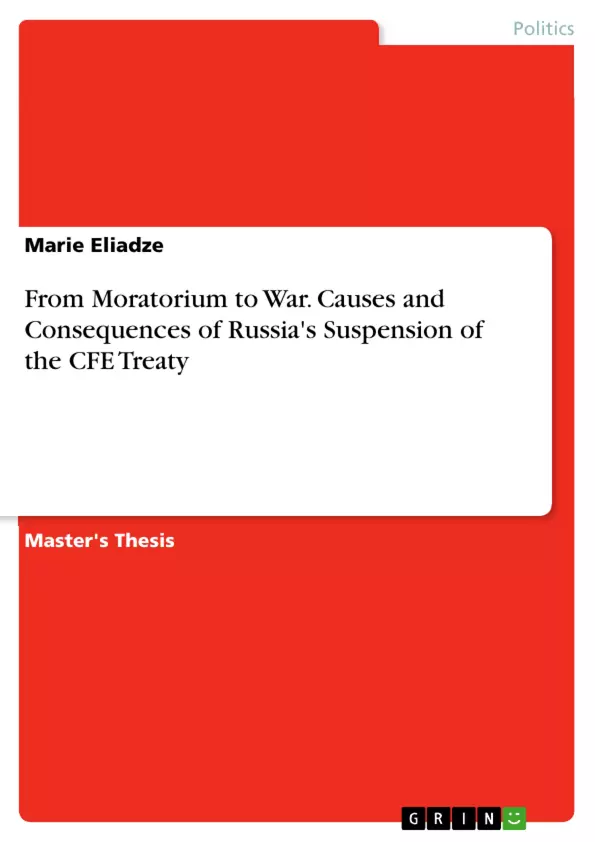The research topic focuses on the concept of European security. With this respect, the Treaty on Conventional Armed Forces in Europe (CFE) is featured as a starting point of 90-ies, 20th century, when security arrangements required to enforce permanent control on conventional weaponry in Europe. Even though the reality today actually differs from the political processes of 90-ies, the fact remains that CFE is considered as a cornerstone of European security.
The core idea is to find a linkage between the moratorium on treaty provisions in 2007 by the signatory party – the Russian Federation – and the consequences that led to the Russian war on the territory of Georgia. Considering the earlier arrangements at the wake of the century, when CFE orchestrated a breakthrough in negotiations to withdraw Russian military bases out of Georgia, it is interesting to focus on the nature of leverage through which the West exercised power to engage Russia into political processes before the moratorium on CFE. The research dimension does not link the moratorium directly with the occupation of Georgia; rather through its emphasis on necessary argumentation, it rationalizes developments after the moratorium, which led the crisis situation in Georgia’s zone of conflict to escalate into armed conflict. Based on hypothetical probability, the discussion basically weighs up the cause and effect relationship between the moratorium and the war. This supports the line of the research to analyze risks that may possibly erode the European security architecture.
Inhaltsverzeichnis (Table of Contents)
- Executive Summary
- Part I
- 1. Research Dimension
- 1.1 Definition of the Topic and its Importance
- 1.2 Goal of the Research
- 1.3 Theoretical Framework
- 1.4 Research Methodology
- 2. Description
- 2.1 Idea and Evolution of the Treaty
- 2.2 Irregularities and Istanbul Summit
- 2.3 Bilateral Agreement between Russia and Georgia
- 2.4 Crisis around CFE
- Part II
- 3. Consequences of the Crisis Escalation
- 3.1 Research Hypothesis
- 3.2 The Factsheet
- 3.3 Crisis Variables
- 3.3.1 Frequency of Irregularities
- 3.3.2 Capacity of Irregularities
- 3.3.3 Dimension of Irregularities
- 3.4 Impact of Variables on the Escalation of the Crisis
- 3.5 Milestone of the Escalation of the Crisis
- 4. Crisis Management Potential
- 4.1 Analysis of CFE Efficiency
- 4.1.1 Empirical Probability of Crisis Management
- 4.1.2 Practical Application of Crisis Management
- 4.2 Application of the CFE as a Probability for the Prevention of the War
- 5. From Moratorium to War
- 5.1 Hypothetical Reality
- 5.2 Cause and Effect Relation
- Part III
- 6. Research Assumptions
- 6.1 CFE as a Model
- 6.2 Russian Interpretation of European Security Architecture
- 6.3 CFE as a Cornerstone of European Security Architecture
Zielsetzung und Themenschwerpunkte (Objectives and Key Themes)
The objective of this research is to analyze the relationship between Russia's suspension of the Treaty on Conventional Armed Forces in Europe (CFE) and the subsequent war in Georgia in 2008. It aims to explore the potential consequences of the moratorium on CFE provisions for European security.
- The CFE Treaty as a cornerstone of European security
- The significance of the CFE in managing conventional arms control in Europe
- The potential risks associated with Russia's withdrawal from the CFE
- The role of the CFE in preventing the escalation of conflict
- The impact of the moratorium on the European security architecture
Zusammenfassung der Kapitel (Chapter Summaries)
- Part I: This part establishes the research context and framework, delving into the definition, importance, and goals of the research. It explores the historical development of the CFE Treaty, highlighting key milestones, irregularities, and agreements between Russia and Georgia. The chapter concludes with an examination of the evolving crisis surrounding the CFE.
- Part II: This part focuses on the consequences of the escalating crisis, analyzing its variables, including frequency, capacity, and dimension of irregularities. It examines the impact of these variables on the escalation of the crisis and identifies key milestones in its progression. The chapter then delves into the potential for crisis management, evaluating the CFE's efficiency and exploring its practical application in preventing conflict. It concludes with an analysis of the potential link between the moratorium on the CFE and the outbreak of war in Georgia, exploring the cause-and-effect relationship.
- Part III: This part presents research assumptions, exploring the CFE as a model for arms control, examining Russia's interpretation of European security architecture, and emphasizing the treaty's role as a cornerstone of European security.
Schlüsselwörter (Keywords)
Key concepts explored in this research include the Treaty on Conventional Armed Forces in Europe (CFE), European security architecture, arms control, crisis management, conflict escalation, Russia's foreign policy, Georgia, moratorium, and war.
- Quote paper
- Marie Eliadze (Author), 2009, From Moratorium to War. Causes and Consequences of Russia's Suspension of the CFE Treaty, Munich, GRIN Verlag, https://www.grin.com/document/385468



